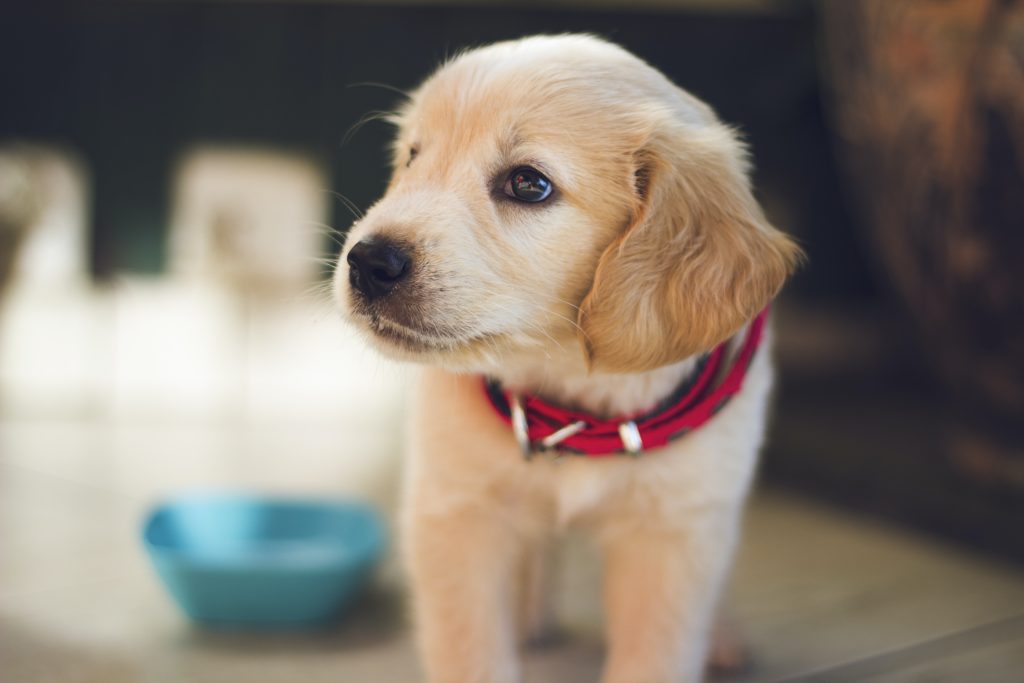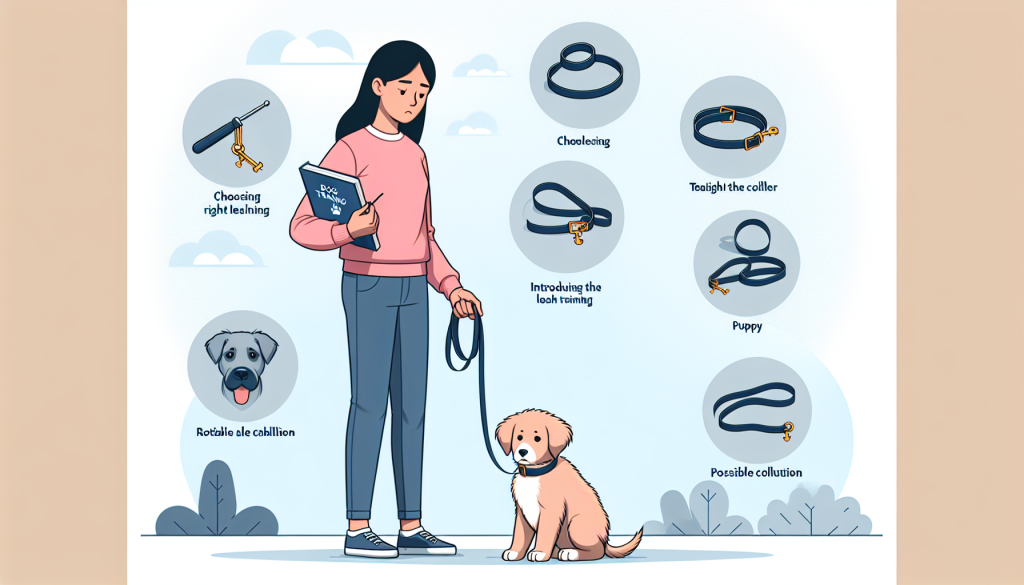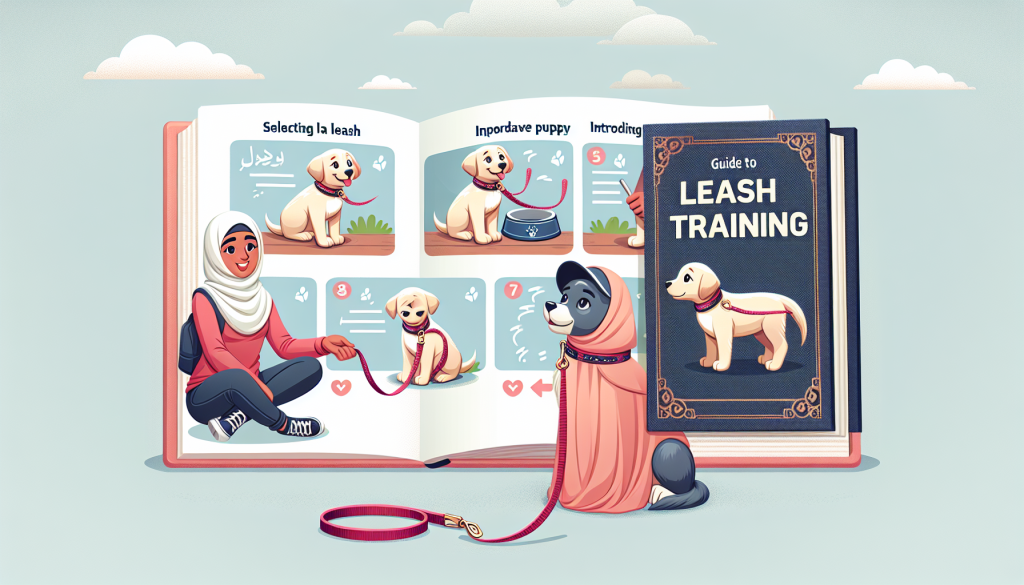Leash training a puppy can be both exciting and challenging. The process of teaching your furry friend to walk politely on a leash requires patience, consistency, and positive reinforcement. In this article, we will guide you through the steps of leash training your adorable pup, helping you create a strong bond and enjoyable walking experiences together. So, grab your pup’s leash, put on a smile, and get ready to embark on this adventure of teaching your puppy how to walk like a pro!

This image is property of images.unsplash.com.
Getting Started
Choosing the Right Leash
When it comes to leash training your puppy, it’s important to start with the right leash. There are different types of leashes available, so it’s essential to choose one that suits your puppy’s size, age, and temperament. A standard leash or a retractable leash can be used for most puppies, but for larger or more energetic breeds, a sturdy and durable leash is recommended. Additionally, consider the length of the leash. A six-foot leash is commonly used for walking and training purposes, as it provides enough freedom for your puppy while still ensuring control.
Introducing the Leash to Your Puppy
Before diving into leash training, you need to introduce your puppy to the leash. Start by letting your puppy explore the leash in a controlled and calm environment. Allow them to sniff and investigate the leash while providing verbal encouragement and praise. It’s crucial to associate the leash with positive experiences right from the beginning. Once your puppy seems comfortable with the leash, you can proceed to the next step of attaching it to their collar or harness.
Preparing for Training Sessions
Preparing for leash training sessions involves creating a positive and structured environment for your puppy. Ensure that your puppy has gone to the bathroom before starting a training session to avoid unnecessary distractions. Choose a quiet and familiar location for training, free from excessive noise or other animals. Keep some treats handy as rewards for good behavior during training. It’s also important to wear suitable footwear and comfortable clothing to ensure you can keep up with your puppy during training sessions.
Basic Leash Training
Teaching Loose Leash Walking
One of the fundamental skills in leash training is teaching your puppy to walk on a loose leash. Start by holding the leash with a relaxed grip and allowing your puppy to explore their surroundings within a small radius. When your puppy begins to pull on the leash, stop moving and wait for them to return to your side. Once they come back to your side, reward them with a treat and praise. This helps your puppy understand that walking by your side is more rewarding than pulling on the leash. Gradually increase the distance and duration of walking by your side, rewarding your puppy for their cooperation.
Positive Reinforcement Techniques
Positive reinforcement is an effective and humane method of training. It involves rewarding your puppy for desirable behavior to encourage them to repeat it. In leash training, positive reinforcement can be used to reward your puppy for walking calmly on a loose leash. Whenever your puppy walks without pulling or lunging, provide them with verbal praise, a treat, or a combination of both. Consistency is key in positive reinforcement training. Be sure to reward your puppy every time they exhibit the desired behavior, reinforcing the connection between good behavior and rewards.
Avoiding Common Mistakes
When leash training your puppy, it’s important to avoid common mistakes that can hinder their progress. One common mistake is allowing your puppy to lead the way instead of walking beside you. Remember, you should be the one leading the walk, not your puppy. Another mistake is using punishment or forceful methods in training. Leash training should always be positive and reward-based. Punishing your puppy for pulling or misbehaving can lead to fear, anxiety, and a breakdown in trust. Patience, consistency, and positive reinforcement are the keys to successful leash training.
Building Leash Skills
Increasing Walking Distance
Once your puppy has grasped the concept of loose leash walking in shorter distances, it’s time to start increasing the walking distance gradually. Begin by walking in a straight line, allowing your puppy to walk by your side. If they start to pull, stop and wait for them to return to your side before continuing. Over time, increase the distance you walk before stopping and rewarding your puppy. This technique helps your puppy understand that they need to stay by your side regardless of the distance you cover.
Adding Distractions
To truly master leash training, your puppy needs to learn to walk calmly even in the presence of distractions. Start by introducing mild distractions, such as toys or low-level noises, during your training sessions. If your puppy becomes distracted and starts to pull, use the same technique as before: stop and wait for them to return to your side before continuing. As your puppy becomes more comfortable with mild distractions, gradually increase the intensity of the distractions. This helps your puppy develop focus and self-control, essential skills for successful leash walking.
Practicing Turns and Stops
Walking in a straight line is just one part of leash training. To build well-rounded leash skills, it’s important to practice turns and stops. Teach your puppy to respond to verbal cues for turning left or right and stopping. Start with gentle turns and stops and gradually increase the complexity and frequency. This helps your puppy learn to pay attention to you and follow your lead. Incorporating turns and stops into your walks not only strengthens your puppy’s leash skills but also keeps them mentally engaged during walks.
Socializing and Leash Training
Meeting Other Dogs On-Leash
Socializing your puppy with other dogs is an important part of their development, but it’s crucial to do so in a controlled and safe manner. When encountering other dogs on-leash, maintain control of your puppy and keep a safe distance. Allow your puppy to observe and sniff from a distance, rewarding them for calm behavior. As your puppy becomes more comfortable, gradually decrease the distance between them and other dogs, always monitoring their reactions. Remember, not all dogs may be friendly or receptive, so it’s essential to prioritize your puppy’s safety.
Encountering People and Children
Similar to meeting other dogs, the encounter with people and children should be positive and safe for your puppy. For leash training purposes, it’s important to teach your puppy to remain calm when passing by strangers. Start by creating distance between your puppy and the person or child, gradually decreasing the distance as your puppy becomes comfortable. Reward your puppy for calm behavior, and be attentive to any signs of fear or unease. Always prioritize your puppy’s well-being and ensure a positive interaction with people and children.
Handling Different Environments
Leash training should not be limited to just one type of environment. It’s important to expose your puppy to different environments to help them become adaptable and confident. Take your puppy for walks in urban areas with traffic, in parks with various sounds and smells, and even in quiet suburban neighborhoods. Pay attention to your puppy’s reactions and body language in different environments. Gradually increase the complexity of the environments to build their resilience and confidence. This way, your puppy will be better prepared to handle any situation they may encounter on a leash.

This image is property of images.unsplash.com.
Troubleshooting Leash Issues
Pulling and Lunging
Pulling and lunging on the leash are common issues faced by puppy owners. To address these issues, it’s important to remain calm and consistent in your approach. When your puppy pulls or lunges, stop walking and wait for them to come back to your side. Reinforce the behavior of walking calmly on a loose leash with rewards and praise. You can also try changing directions whenever your puppy starts to pull, as this helps them refocus on you. Consistency and patience are key to overcoming pulling and lunging behaviors.
Barking and Growling
Some puppies may exhibit barking or growling behaviors while on a leash, especially when they encounter unfamiliar people or dogs. It’s important to address these behaviors to ensure a safe and pleasant walking experience. One approach is to redirect your puppy’s attention by using treats or toys to distract them from the triggering stimulus. Reward your puppy for calm behavior and provide positive reinforcement when they remain quiet and composed. If the barking or growling persists, seek guidance from a professional trainer or behaviorist to address the underlying issues.
Fear and Anxiety
Leash training can sometimes trigger fear and anxiety in puppies, especially if they have had negative experiences in the past. To help your puppy overcome fear and anxiety, create a soothing and supportive environment during training sessions. Gradually expose them to the stimuli that trigger their fear in a controlled and positive manner. Use treats, rewards, and praise to reinforce positive associations and build their confidence. If your puppy’s fear or anxiety persists or worsens, consult with a professional trainer or behaviorist for guidance and specialized techniques.
Advanced Leash Training
Off-Leash Training Commands
Once your puppy has mastered basic leash skills, you can move on to advanced off-leash training. This involves teaching your puppy crucial commands such as “come,” “sit,” and “stay.” These commands are important for ensuring your puppy’s safety and control, even when off-leash. Start by practicing these commands in a controlled and secure environment, gradually increasing the level of distractions. Consistency, repetition, and positive reinforcement are key to successful off-leash training.
Off-Leash Recall Training
Recall training is an important aspect of off-leash training. Teaching your puppy to come when called can potentially save their life in dangerous situations. Start recall training in a secure and enclosed area, such as a fenced yard. Use a positive and enthusiastic tone when calling your puppy, and reward them with treats and praise when they respond promptly. Gradually introduce distractions and practice recall in different environments. It’s important to remember that off-leash recall training should only be attempted in safe and secure areas.
Proofing Leash Skills
Proofing your puppy’s leash skills ensures that they remain reliable in any situation. This involves practicing their leash skills in different environments, with various distractions, and around other dogs and people. By exposing your puppy to different scenarios and challenging them in a controlled manner, you can reinforce their leash skills and ensure they respond appropriately regardless of the circumstances. Regularly review and practice their leash skills to maintain their reliability and confidence.

This image is property of images.unsplash.com.
Training Tools and Equipment
Choosing the Right Collar or Harness
Selecting the appropriate collar or harness for your puppy is an important decision in leash training. There are various options available, including flat collars, martingale collars, and front-clip harnesses. Consider factors such as your puppy’s size, breed, and behavior when choosing the right collar or harness. Ensure that the chosen collar or harness is properly fitted and comfortable for your puppy. It’s recommended to consult with a professional trainer or pet store associate to help you choose the most suitable option for your specific puppy.
Using Long Lines or Flexi-Leads
Long lines and flexi-leads can be useful tools when building your puppy’s leash skills. Long lines provide extra length while still maintaining control, allowing your puppy to explore and roam within a safe distance. Flexi-leads, on the other hand, offer retractable functionality, giving your puppy more freedom to wander while still being connected to you. When using long lines or flexi-leads, it’s important to be mindful of your surroundings and ensure the safety of your puppy and others around you.
Utilizing Treats and Rewards
Treats and rewards are valuable tools in leash training and can be used to reinforce positive behavior. Choose small, easily manageable treats that your puppy finds highly desirable. During training sessions, reward your puppy with treats and verbal praise when they exhibit the desired behavior, such as walking on a loose leash or responding to a command. Gradually decrease the frequency of treats as your puppy becomes more proficient in their leash skills, but continue to provide verbal praise and occasional rewards to maintain their motivation.
Training Tips for Different Puppy Breeds
Working with Small Breeds
Leash training small breeds requires some special considerations. Small breeds often have smaller necks and delicate structures, so it’s important to choose lightweight and properly fitted collars or harnesses. Ensure that the leash or long line you use is light enough for your small breed to comfortably manage. Take shorter walks initially and gradually increase the distance as your small breed builds stamina. Additionally, be mindful of environmental hazards such as extreme heat or cold, as small breeds may be more susceptible to temperature-related issues.
Training Large and Energetic Breeds
Training large and energetic breeds on a leash requires patience, consistency, and strong control. Ensure that you choose a sturdy collar or harness that can handle their strength. Utilize long lines or flexi-leads to give them more space to move and explore while still maintaining control. Regular exercise and mental stimulation are crucial for large and energetic breeds, as they have higher energy levels. Incorporate activities such as fetch or agility training into your training sessions to help them release their energy in a productive and controlled manner.
Training Brachycephalic Breeds
Brachycephalic breeds, such as Bulldogs or Pugs, have unique anatomical features that can impact their leash training experience. These breeds may have difficulty breathing, especially during strenuous activity or warm weather. It’s important to choose a harness that does not put pressure on their sensitive trachea and use gentle walking methods. Take frequent breaks during walks to allow your brachycephalic breed to catch their breath. Additionally, be mindful of the temperature and ensure that they do not overexert themselves. Consult with a veterinarian for specific guidance tailored to your brachycephalic breed.

Maintaining and Reinforcing Leash Skills
Regular Exercise and Walks
Regular exercise and walks are essential for maintaining your puppy’s leash skills. Physical activity helps them release energy, stay fit, and reinforces their ability to walk calmly on a leash. Engage in daily walks that challenge your puppy both mentally and physically. Incorporate different environments, varying distances, and occasional changes in pace to keep your puppy engaged and improve their overall leash skills.
Consistency in Training
Consistency is key when it comes to leash training. Establish a routine that includes daily training sessions and stick to it. Consistent reinforcement of desired behaviors and prompt correction of undesirable behaviors helps your puppy understand expectations. Ensure that all family members follow the same training techniques and use consistent commands and cues. By maintaining a consistent training approach, your puppy will better understand what is expected of them and progress more effectively.
Reward-Based Reinforcement
Continue to reinforce your puppy’s leash skills through reward-based training. Even after your puppy has mastered basic leash skills, it’s important to provide occasional rewards and praise to reinforce their good behavior. This helps maintain their motivation and strengthens the positive association with being on a leash. Remember to use treats sparingly and transition to verbal praise and occasional rewards as your puppy becomes more proficient in their leash skills.
Conclusion
Leash training a puppy requires patience, consistency, and positive reinforcement. By choosing the right leash, introducing it gradually, and preparing for training sessions, you set the stage for successful leash training. Basic leash training focuses on teaching loose leash walking, positive reinforcement techniques, and avoiding common mistakes. Building leash skills involves increasing walking distance, adding distractions, and practicing turns and stops. Socializing and leash training go hand in hand, involving meeting other dogs on-leash, encountering people and children, and handling different environments. Troubleshooting leash issues addresses pulling and lunging, barking and growling, and fear and anxiety. Advanced leash training explores off-leash training commands, off-leash recall training, and proofing leash skills. Utilizing the right training tools and equipment such as collars or harnesses, long lines or flexi-leads, and treats and rewards enhances the training process. Tailoring training tips for different puppy breeds ensures successful leash training for small breeds, large and energetic breeds, and brachycephalic breeds. Maintaining and reinforcing leash skills includes regular exercise and walks, consistency in training, and reward-based reinforcement. With dedication and positive reinforcement, you and your puppy will enjoy many enjoyable and rewarding walks together.
